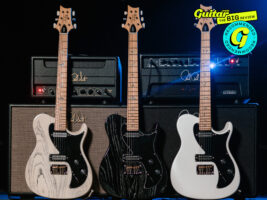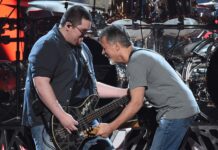
PRS SE NF 53 review: “it might look like PRS’s Telecaster, but this is its own guitar”
$979/£979, prsguitars.com
Paul Reed Smith hasn’t got to where he is today by being afraid of ruffling a few feathers. The Maryland guitar maker’s success over the last 40 years has been built on finding new and innovative ways to evolve the electric guitar while always being inspired by its iconic heritage.
READ MORE: Five times the Hives were the best band in the world (according to the Hives)
Sometimes it’s meant that PRS has attracted its fair share of criticism – remember the outcry when the Silver Sky was first launched? Well, now the ‘PRS Strat’ regularly outsells its inspiration, and the naysayers have gone very quiet.
It was a very similar scenario when Alter Bridge’s Myles Kennedy started being spotted with a noticeably T-style PRS guitar on stage a few years back. Sections of the internet were widely incensed by the guitar’s very existence, and weren’t shy about letting people know this fact when the guitar, dubbed the NF 53, and its Kennedy signature sibling launched just over two years ago.
Image: Press
Some people loved to hate on the NF 53 and MK. Especially in their unconventional ‘doghair’ finishes – which uses contrasting-colour grain filler to give a striking effect. But then PRS revealed that the guitars were the brand’s top two best-selling USA guitars in 2023, despite only being launched in June of that year.
Again, the naysayers went quiet, and the stage was set for the NF 53 to follow the Silver Sky into the SE range, where the ‘PRS Telecaster’ could truly become a disruptive force in the T-style market. And here, two years on, is the result.
PRS SE NF 53 – what is it?
The first thing to be aware of is that this is not simply a Telecaster with a PRS headstock. Smith’s reputation as one of the most important and innovative minds in the history of electric guitar design is based on his ability to take something and evolve and iterate on it to create a modern instrument that’s more versatile and more reliable.
So yes, on the surface the SE NF 53, like its US-made forebear, is a single-cut, swamp ash-bodied guitar with a bolt-on maple neck that sports 22 frets and a 25.5” scale length. At the other end you’ll find a plate-style steel bridge, a pair of pickups and a control layout that comprises a shared volume and tone controls and a three-way blade selector switch. So far, so Fullerton.
But, this is where the PRS magic so often resides – because a closer look will see that this is not your grandaddy’s T-type in almost every way that matters. That swamp ash body has a more rounded feel than the original, with some well-considered contours on the back and around the cutaway to make it sit a little better.
That bridge I mentioned? It’s Smith’s own design, and sports a pair of adjustable brass saddles – one for the treble strings and one for the bass. Then there are the pickups that give this guitar its name.
Image: Press
Instead of traditional single coils, here you’ll find a pair of PRS’s Narrowfield DD (Deep Dish) “S” units. These differ significantly from the traditional with taller bobbins to fit more winds and extra metal pieces in between the magnets for a focused, powerful tone – this is every bit a noiseless humbucker, but one designed for twang as well as rock.
The one notable difference between the SE version and its US counterpart is the pickguard – the dinky option on the original has been replaced with a sweeping Custom-style plate that holds the pickups and all the controls.
The obvious reason for this is to make this guitar easier and cheaper to build. Instead of having to individually mount each pickup and pot to the body (which involves both front and back routing), you can simply borrow a lesson from the Strat and mount everything on the ‘guard, meaning a much more straightforward assembly at scale.
And, whisper it, but I think the guitar actually looks better with the larger guard – sometimes mass production can have unintended benefits…
PRS SE NF 53 – build quality and playability
Pulling the SE NF 53 out of its included gigbag and the first thing you have to remark on is the finish. I have the ‘White Doghair’ option – which is probably the most polarising of the three offered at launch. It features an off-white base coat with black filler in the grain, giving a striking presentation of the grain of the swamp ash.
Many will probably prefer the flat white option, or indeed the less overt Black Doghair option, but I dig it – it reminds me of a meerschaum pipe in some ways. It’s certainly a conversation starter. It’s also gloss-finished so you won’t get the tactile feel of the wood grain, even if it might look it from a distance.
Image: Press
PRS’s SE line has been the benchmark for build quality and consistency for import guitars, and nothing about the NF 53 challenges that reputation. The finish is expertly applied and every screw, joint and part feels solid, snug and reliable.
One thing that’s also hard to ignore is the weight. Swamp ash is a wood in increasingly short supply, and so you have to expect that the stuff being used for a sub-$1,000 guitar isn’t going to be the absolute cream of the crop. Still, it was an eyebrow raiser to see this guitar tip the scales at around 8.5lbs/3.8kgs. While I’ve played other SE NF 53s that weigh considerably less than this, I’ve also seen some that weigh even more.
Some people will not have an issue with this kind of heft, of course, and if it pays you back with more sustain than you’d normally expect it could be a worthy trade-off. But a T-type that’s verging on Les Paul territory weight-wise is still something you’ll want to be aware of.
Strapping it on and those extra body contours make an instant case for themselves, making the guitar sit in a way that feels comfortable and ergonomic. It’s helped by a very welcoming but still characterful playing experience. It’s a very full neck shape, but thanks to the immaculately applied satin finish, it’s still very comfortable. What’s more, due to the 25.5” scale length strings bend more easily, almost like it is a tremolo guitar instead of a hardtail. The neck shape is very full, but it doesn’t feel it thanks to the satin finish.
PRS SE NF 53 – sounds
The NF 53 has a bright and resonant unplugged quality – perhaps not as lively as its US-made brethren but it still feels alive in the hands. The bigger test is to come of course – the plugged in T-style sound is iconic and distinctive, but is that even what we’re going for here?
In short: no. Putting the NF 53 into an amplifier and it becomes instantly clear that while this guitar has a bevvy of sounds at its disposal, it’s not a Telecaster in the traditional sense. The overall tonality is cleaner and less brittle or biting.
Image: Press
These Deep Dish pickups have a sound that’s very much their own, but that’s no bad thing at all – if pushed I’d say they sit somewhere between P-90s and mini-humbuckers. In practice, it gives you a very full tonality played cleanly, but adding some gain is where this guitar really comes into its own.
With overdrive and distortion, the pickups really fill out – adding body and beef, and a very impressive amount of sustain and grit. But that’s not all – shape the tone of your amp and controls to extract a nice helping of T-style twang from the NF 53, too. It’s perhaps not quite as spanky as the classic, but it’s nice to be able to go there when you need to.
PRS SE NF 53 – should I buy one?
The NF 53 might look like PRS’s Telecaster, but this is very much its own guitar. The sounds are beefy and muscular, and it definitely loses a little bit of the T-type character as a result of that. But you can argue that what we gain here is probably more useful and usable for today’s musician anyway.
Because that’s the thing, this isn’t a PRS take on a classic – that’s not the way Paul Reed Smith operates. He’s reinterpreting the bolt-on singlecut for the needs of the modern player – and in doing so he’s departed from many of our traditional notions for what this type of guitar should be.
You can also make the argument that there are plenty of great traditional T-style guitars in this price point with Fender on the headstock, and so what would be gained from adding another? Again, this is not PRS’s style.
Instead what we get is a guitar that evokes that lineage but adds something different to the pot – all while adding a level of build, fit and finish that continues to set the SE line apart from the rest of the (rapidly improving) Asian-made pack.
Be careful though, plug one in, and you might find yourself going home with it – it’s just that good. In fact, it might be the best SE PRS yet..
PRS SE NF 53 – alternatives
It would be rather silly to talk about T-type alternatives and not start with Fender’s own of course. The Mexico-made Player II and Player II Modified range offer an upgraded and more pro-ready take on the traditional recipe, and its Telecaster ($1,049/£949) is very impressive. If you want another affordable T-type that is sonically on another plane, Manson’s MBM-2H (£569) sports a pair of high-output humbuckers and a killswitch.
The post PRS SE NF 53 review: “it might look like PRS’s Telecaster, but this is its own guitar” appeared first on Guitar.com | All Things Guitar.
Source: www.guitar-bass.net












